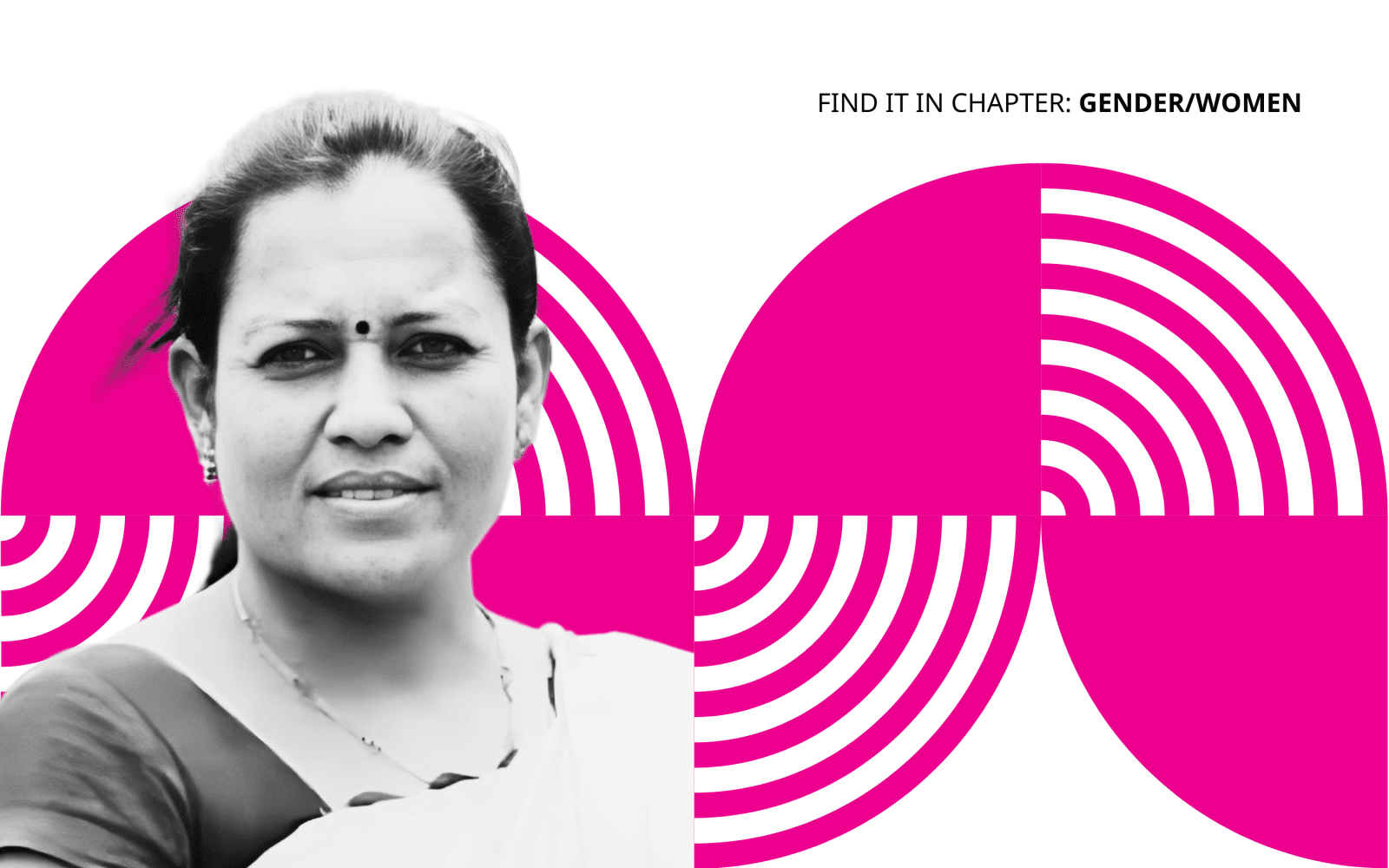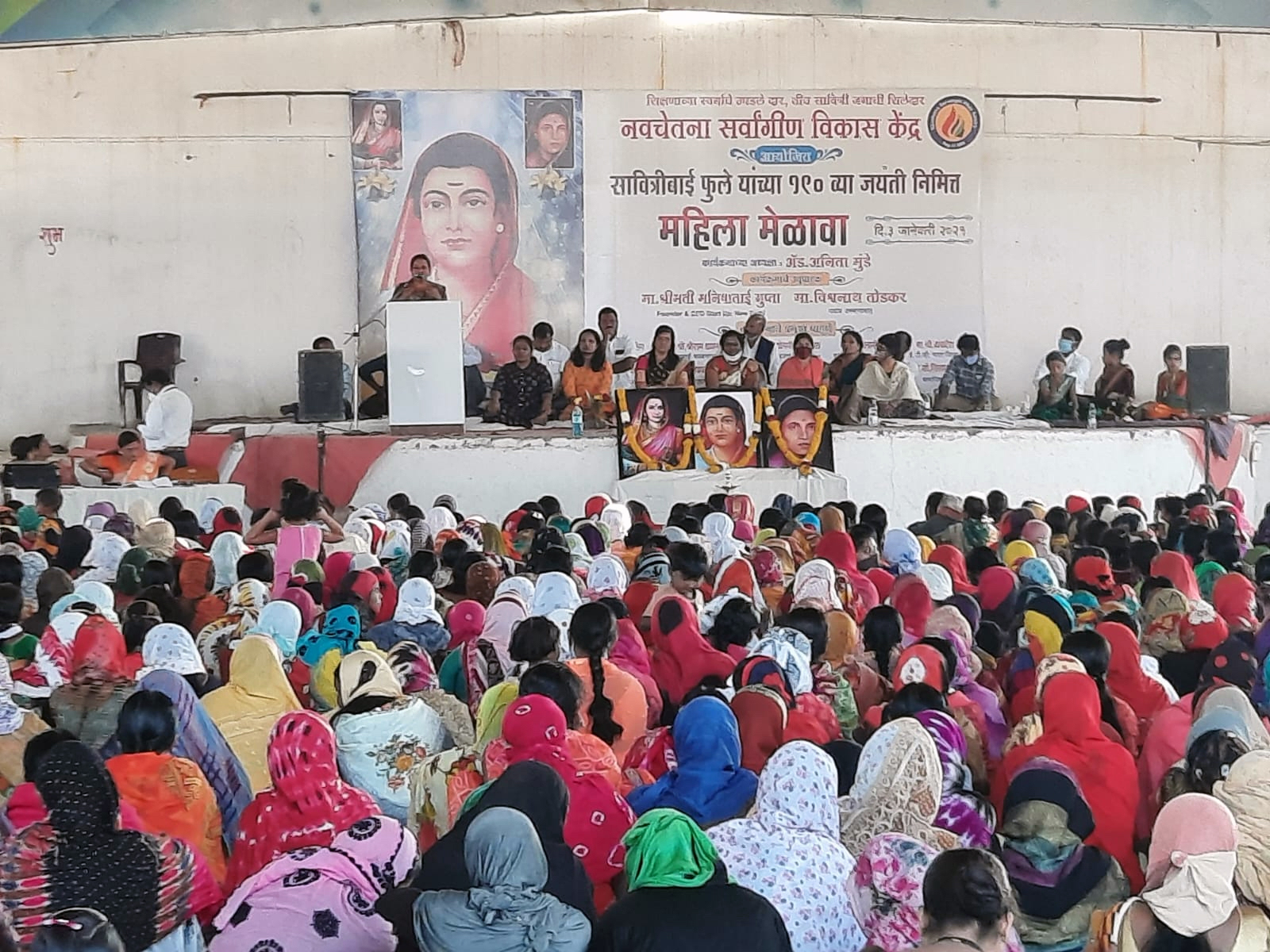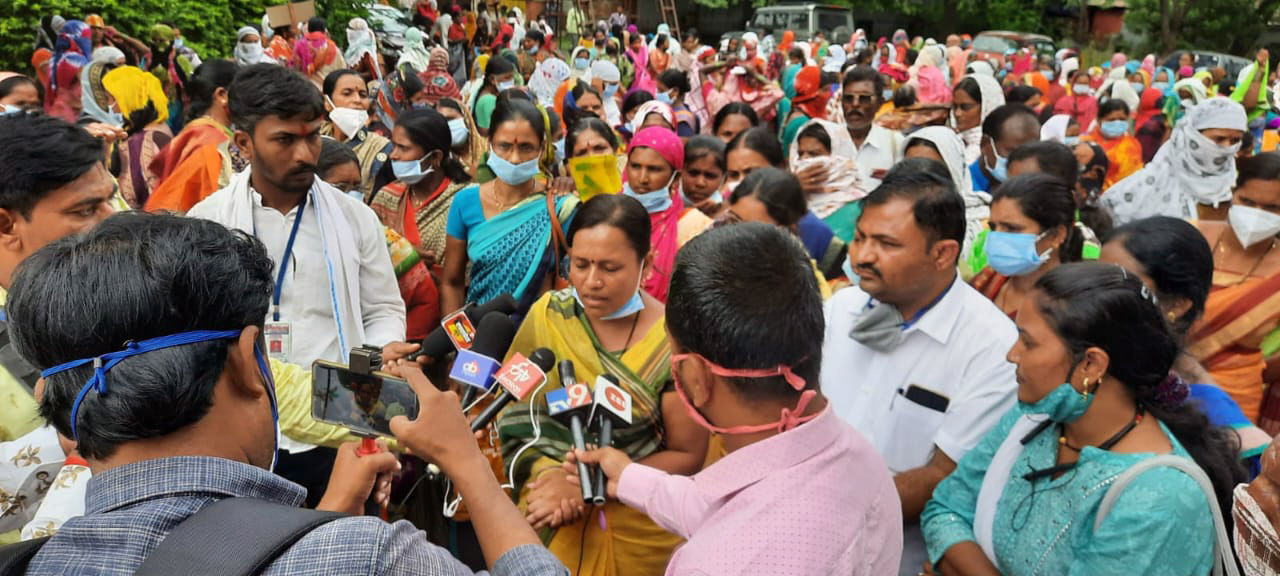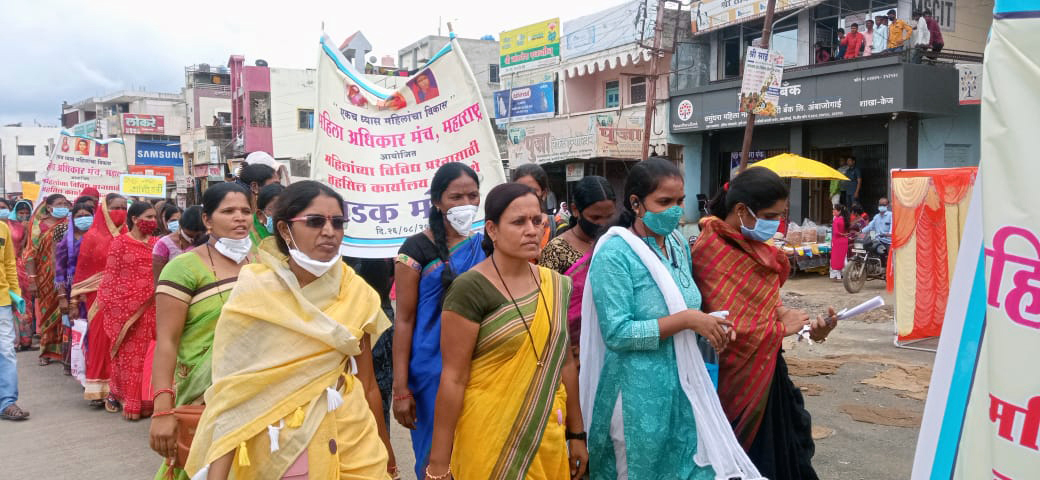Manisha Ghule
Executive Director, NAVCHETANA
Fellow project website: www.navchetna.org
Manisha Ghule is tapping the knowledge, energy, and lived experience of midlife, rural Indian women, ages 30-45, to become village development professionals, raising standards of living and income in their communities as they elevate their own. The skills they develop equip them for new careers, inspiring new cadres of disadvantaged women to follow in their footsteps.

THE NEW IDEA
In rural India, women do much of the livelihoods and agricultural work. However, their contribution is invisible because their roles continue to be informal and grossly underpaid. Despite being the backbone of their village economies, they are little values and barely if at all paid.
Manisha Ghule has found how to turn this pattern upside down. How? She focuses on women who have finished their child-rearing and are savvy and mature, albeit from Dalit and other disadvantaged backgrounds. She gets the village to choose the most promising among such women, and she then gives them a year’s training in how to be a “village developer” or “Sakhi” (“friend”). The Sakhis then spend several years in a dimension of village development (e.g., helping everyone gain access to the government programs for which they are eligible). Once they have finished these two years as village developers, they move to sophisticated jobs ranging from police to modern agriculture.
After intensive training from Manisha’s organization, these Sakhis step into their communities as development professionals, equipped to provide guidance on agriculture, education, personal finance, government support programs, and the like. The Sakhis are selected by their villages for a tenure of three years. Village households pay for the services they provide. In this way, the earnings of the Sakhis become directly linked to better development outcomes in their villages.
Manisha has built village-level architecture to sustain and strengthen the leadership of Sakhis. They lead and own their own goals, performance targets, and service fee structures, all of which are set in consultation with their communities. Being embedded in formal village positions gives the Sakhis authority, enabling them to activate defunct village development committees and programs that are crucial for the progress of their communities.

In four years, 1,200 rural frontline development professionals have emerged across 300 of the poorest villages of Maharashtra, India’s second-most populous state. Communities that employ them report a 60-80% increase in household income. And, from having earned at best subsistence-level wages before, the Sakhis are realizing a 30-50% increase in their own income, making between 140 to 360 USD annually for part-time work of 4-7 hours weekly. Their income rises farther once they move into sharply modern roles after leaving their three years of service.
So far, Sakhis have, for example, incubated 4,500 microenterprises and engaged 3,500 farmers in the bio-farming of high-value crops. They have enabled 20,000 women to become joint owners of property and helped thousands of other women access social protection schemes. More than 3,500 families have been able to leave migrant work for permanent residences, where they can now earn adequate income.
Manisha recognizes that long-term career pathways, not jobs, will build a groundswell of women aspirants for the role of rural frontline development professional. The Sakhis graduate from their three-year tenure equipped with leadership tools, technical expertise, and improved social standing that allow them to step into new careers with new skills and authority. Sakhis who have completed the program are becoming elected as local leaders, founding women-led businesses, entering the police force, and even setting up banks.
"The financial support has led to a sense of confidence, social acceptance, entrepreneurial life skills, and most of all a sense of community to the women. Manisha’s lived experience of the community’s realities enabled her to bring more women forward to access their rights.”
-Financial Express
Manisha has designed this approach to be a sustainable and scalable model for rural development. Over time, she aims to set up state-level platforms where Sakhis can engage in peer learning and collaborate as a professional body. For greater community buy-in and to increase Sakhis’ legitimacy and visibility, Manisha is also partnering with local colleges of social work to research, formalize, and recognize the Sakhi model as a job and role that will open leadership and career pathways for rural women.

THE PROBLEM
In rural India, women do much of the work but are commonly unpaid and invisible. This is especially so far Dalit or other low status women.
Indian women, especially in rural areas, are among the lowest paid in the world, yet more rural women work than urban women. Nearly 75 percent of rural Indian women are informally engaged in agriculture, but despite their lived experience and knowledge, they are little valued and less paid.
In the last five years, the marginalization of rural women has accelerated. Immediately after the first wave of COVID, more than 12 million rural women lost their jobs. By 2030, another almost 12 million, especially those in agriculture, could lose their jobs owing to automation, according to a McKinsey Global Institute report.
"Manisha Ghule, who has been working with the affected women, said the state health department’s failure to recognise the long-standing trend of women as young as 20 undergoing hysterectomy was “significant and a collective tragedy, for which the authorities need to share the responsibility”.
-The Indian Express
The picture is worse for the nomadic and so-called “denotified tribes,” or DNT communities in Manisha’s home state of Maharashtra. These landless families are the most vulnerable. Many earn their living from cutting sugarcane, migrating with their entire families for six to eight months a year to live and work in subhuman conditions. Although they are the backbone of the state’s sugar industry, among the most profitable in the country, the average family income among the DNT community is less than 900 USD a year. Women from DNT families in Manisha’s region are often coerced to have hysterectomies so that they don’t have to skip a day of work during their menstrual cycle.
For a long time, there has been widespread recognition by all sectors that women are key to reviving rural India. Yet opportunities that have engaged rural women have been limited and limiting. The government has instituted roles for rural women such as community health workers, rural childcare center staff and the like; yet despite their reach and impressive work in remote corners of the country, women continue to be viewed as cheap, temporary and last-minute labor. They receive limited technical training, are usually not engaged in leadership programs, and are even denied their service fee for years when governments run deficits. Nonprofit organizations working in rural areas often do recruit and train rural women, but this cadre gets remunerated only for delivering field services within the remit of the organization.
THE STRATEGY
Manisha recognizes that rural India has a giant opportunity – engaging its huge, little-used talent: Its sea of middle-aged women. She is focused on the domains of climate-resilient agriculture, livelihood generation, and social protection, where rural women experts can apply their lived experience, knowledge, and new skills to turn around ailing village economies.
As the daughter of an ultra-poor family of sugarcane cutters, Manisha has drawn her blueprint by looking into her own life. Hailing from historically marginalized communities, her cadres of frontline professionals are comprised of women between the ages of 30 and 45, who are selected at a lifecycle stage at which they have accumulated experience and have leverage with their families and communities. Most have built a solid fund of grit and equanimity. Their children are also older, freeing up their time and mind space to focus on a career.
These rural frontline development professionals are launched through a structured process of identification and selection. The Sakhis are selected by a village council and validated by female village collectives, a platform set up by Manisha and her team, with representation from women from all village households. Five to seven women are nominated for four or five specific roles, with room for dropouts or other exigencies.
A one-year Leadership Development Academy transforms these women with limited formal education into rural frontline development professionals. Curated by Manisha and her team, leadership immersion includes technical training, leadership development, on-site learning, coaching, and peer support. The Academy curriculum blends the Sakhis’ knowledge of their village communities with the technical know-how of thematic experts. The faculty ranges from progressive local farmers to experts from financial institutions, including the National Bank for Agriculture and Rural Development, leaders in agribusiness, and representatives from government and non-profits.

The leadership academy is a springboard for Sakhis to develop the skills needed for their new positions. In every village, five frontline development professionals take on the critical roles of village livelihood officer, agriculture service provider, education officer, social entitlements officer, and Police Mitra or friends of the police. Together, they build new knowledge, practices, and behaviors in their villages, that have otherwise seen few or no development interventions.
"According to Manisha Ghule, who has worked with more than 7,000 families, there is no separate government scheme or help for sugarcane workers; they make do with universal schemes like ration cards.”
-newslaundry
The Livelihoods Development Officer provides village women the technical services of setting up self-help groups, opening bank accounts, managing record books, incubating micro-enterprises, setting up market linkages, and serving as rural business coaches. The Agriculture Officer engages marginal, small plot holders in climate-resilient farming methods that restore the nutrient balance of soils, recharge natural irrigation systems, and cultivate water-efficient crops. The Education Officer maintains a strict track record of the schooling of children of migrant families and provides care and upkeep services for children in village seasonal hostels. The Police Mitra ensures, for example, steady and timely access to the justice system for women survivors of violence. All five role holders collaborate on the more complex and intersectional challenge of securing women’s access to property and land rights and unlocking government schemes and programs.
To prevent the Sakhis from getting relegated to an informal or temporary workforce, Manisha has integrated them into the panchayat system, a village-level governing structure with locally elected leaders. Being embedded in formal village positions gives the Sakhis confidence and authority, enabling them to activate defunct village development committees and programs that are crucial for the progress of their communities.
The Sakhis’ effectiveness in these roles is uprooting attitudes that have long blocked rural women’s leadership in India. The Sakhis are able to serve throughout their village, overcoming social norms that otherwise frown upon women leaving the home to work. Through the social capital they build, Sakhi are able to engage as professionals with everyone across their communities – while still keeping up with household responsibilities. Though they are not formally educated, their wealth of lived experience and Sakhi training enables them to have major impacts on their communities.
Manisha’s model also makes business sense, as the increase in villagers’ incomes enables them to pay the Sakhis. Sakhis earn up to 360 USD for 50-75 days of their time every year. They also harvest the recognition factor, as they stand tall in their communities as go-to-advisors, ‘business doctors,’ ‘crop experts’ and ‘panchayat leaders.’
As a further test of sustainability, Manisha’s model works without any external funding.
THE PERSON
Manisha was born into a family of agricultural wage laborers in a remote village in Maharashtra, in a district known for violence and corruption. When she was nine months old, her parents left her and her siblings in the care of their grandparents, to seek work in distant sugarcane fields. Despite poverty and the routine of eating one full meal every alternate day, Manisha recalls being a happy child. She experienced care and well-being from her siblings and grandparents.
Manisha’s life was upended after her marriage at the age of 13. Her education came to a grinding halt. In her marital home, she experienced extreme physical, sexual, and psychological violence. Shouldering the burden of agricultural and domestic responsibilities, she gave birth to her son at the age of 15. In a life-altering episode of violence, Manisha was flung into the village well one night by her husband and in-laws. She was pregnant with her second child at the time. Manisha survived the night in the swirling dark waters. This was a watershed moment, the moment when she decided to walk out on violence and give herself permission to build a life of purpose.
The threat of social ostracization drove Manisha’s natal family to reject her and her children. But her aunt, a single woman, stood up in her support. With her aunt as her tailwind, Manisha, a single, penniless mother of two, set on a new path of grit. During the day, she earned money as a domestic helper and cleaner in a local NGO. She studied at night. With scholarship support and mentorship of a village schoolteacher, Manisha topped her high school exams. She went on to complete her undergraduate and postgraduate education in social work.

Photo Credit: Manisha Ghule
But Manisha’s real education came from her role as a community worker. She fought many attitudinal barriers to get a job as a field coordinator in the same rural civil society organization that had employed her as a cleaning woman. In this role, she was responsible for some of the activities that today fall within the remit of a rural frontline development professional. The role gave Manisha a new lens. It opened multiple new windows for her to read her own community. She understood that she and those placed like her were not worthless, but that structural violence and exclusion mounted huge obstacles on their path to progress.
Manisha also witnessed other forms of discrimination. In her nonprofit, Manisha and the other field-worker colleagues, who came from local communities, were not consulted on program matters by the managers and leaders of the organization. And there were limited or no pathways of career progression for them.
In 2008, Manisha launched her organization Navchetana, with seven other single rural women. Manisha studied diligently to learn the basics of organizational management, administration, compliance, and fundraising. The absence of clear information, advice, and roadmaps led her to realize the need for development management training for grassroots women who are off the grid of the development sector.
It took her ten years to develop her idea. In 2018, she rolled out a radically new idea – turning disadvantaged middle age rural women into the development frontline professionals.